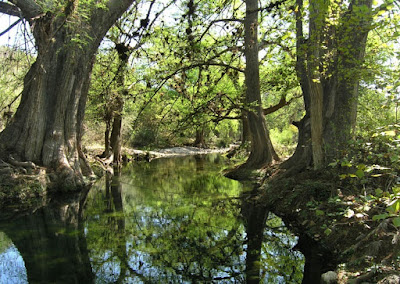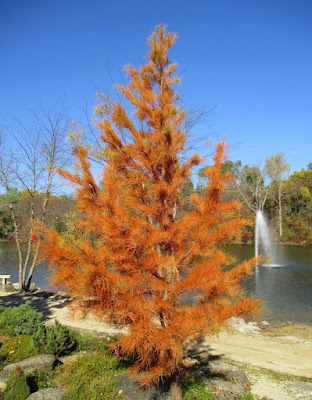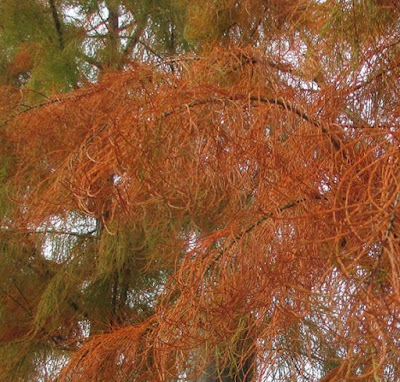|
|
 |
| Taxodium mucronatum – Montezuma Bald Cypress |
T. mecronatum is evergreen to partly deciduous foliage tree.
It is a large tree, growing up to 40 m (130 ft) in height and the trunk is 1-3
m (3.3 – 10 ft) in diameter. The leaves are medium to light green in color.
They are spirally arranged but twisted at the base to lie it two horizontal
ranks, 1 – 2 cm (0.4 – 0.8 in) long and 1 – 2 mm broad.
Both sexes’ flowers are found in the same tree. The male
flowers are borne in long racemes, whereas common Bald cypress is deciduous and
the male flowers are in short clusters but Montezuma Bald is in long clusters
that resemble oak catkins, 15 – 30 cm (6 – 12 in) long, with the individual
flowers spread out spirally along the central thread-like stem; color is brown.
Female cones are small and inconspicuous swellings on the previous year's
branchlets. The globose cone, 1.5 – 2.5 cm (0.6 – 1 in) long and 1 – 2 cm (0.4
– 0.8 in) broad, surface rough, green and glaucous at first, but turning brown
and woody when matured.
Montezuma cypress is the national tree of Mexico. It is
mainly plant as ornamental tree since very long time ago. It is frequently cultivated in Mexican parks
and gardens. The wood used make house beams and furniture. This tree has a
great medical value. The local people used its resin to treat gout, ulcers,
skin disease, wounds, and toothaches. The bark and wood also used as medic. The
leaves acted as relaxant and could help reduce itching.
 |
| Taxodium mucronatum – Montezuma Bald Cypress |
 |
| Young Plant of Montezuma Bald Cypress |
 |
| Montezuma Bald Cypress Young Plants |
 |
| Taxodium mucronatum Young Plant |
 |
| Leaves of Montezuma Bald Cypress |
 |
| Taxodium mucronatum Leaves |
 |
| Montezuma Bald Cypress Leaves |
 |
| Male Flowers of Montezuma Bald Cypress |
 |
| Taxodium mucronatum Male Flowers |
 |
| Montezuma Bald Cypress Male Flowers |
 |
| Female Cone of Montezuma Bald Cypress |
 |
| Taxodium mucronatum Female Cones |
 |
| Bark of Montezuma Bald Cypress |
 |
| Taxodium mucronatum Bark |
 |
| Montezuma Bald Cypress Bark |
 |
| Log of Montezuma Bald Cypress |
 |
| Taxodium mucronatum Log |
 |
| Ornamental Plants of Montezuma Bald Cypress |
 |
| Taxodium mucronatum Ornamental Plant |
 |
| Taxodium mucronatum Log |
 |
| Taxodium mucronatum – Montezuma Bald Cypress |
 |
| Logs of Montezuma Bald Cypress |
 |
| Taxodium mucronatum – Montezuma Bald Cypress |
 |
| Taxodium mucronatum – Montezuma Bald Cypress |
 |
| Taxodium mucronatum – Montezuma Bald Cypress in Fall |
 |
| Taxodium mucronatum – Montezuma Bald Cypress |
 |
| Taxodium mucronatum – Montezuma Bald Cypress |
 |
| Taxodium mucronatum – Montezuma Bald Cypress |
 |
| Taxodium mucronatum – Montezuma Bald Cypress |
 |
| Taxodium mucronatum – Montezuma Bald Cypress |
Video of Montezuma Bald Cypress:




























